Publications

A Resampled Tree for Many Lights Rendering
Alejandro Conty, Pascal Lecocq, Chris HellmuthIn SIGGRAPH 2024 Talks
We propose a new hybrid method for efficiently sampling many lights on a scene that combines a simplified spatial tree with a resampling stage. Building on previous methods that work with a split or cut of the light tree, we introduce the idea of probabilistic splitting to eliminate noise boundaries. This yields a small but unbounded subset of lights that is then reduced to a smaller and bounded set which is used for full light/BSDF evaluation for resampling. Our main contribution is the stochastic splitting formulation combined with a Reservoir Set concept which can limit samples to an arbitrary number, allowing two stages of resampling with different heuristics.
[pdf] [supplemental] [bib]
Spear: Across the Streaming Multiprocessors: Porting a Production Renderer to the GPU
Clifford Stein, Chris Hellmuth, Alejandro Conty Estevez, Pascal Lecocq, Larry GritzIn DigiPro '24: Proceedings of the 2024 Digital Production Symposium
We ported the Sony Pictures Imageworks version of the Arnold Renderer to the GPU using NVIDIA’s OptiX ray tracing toolkit. This required modifying algorithms to run efficiently on the GPU, the use of new software methodologies to better share source code between the host and device renderers, and a reevaluation of what contributes to poor performance on the device. We share here the key decisions we made to overcome these challenges and the valuable lessons we learned during our journey in implementing the Sony Pictures Evolved Arnold GPU Renderer (Spear).
[pdf] [bib]
A Microfacet-Based Shadowing Function to Solve the Bump Terminator Problem
Alejandro Conty Estevez, Pascal Lecocq, Clifford SteinIn Ray Tracing Gems (2019)
We present a technique to hide the abrupt shadow terminator line when strong bump or normal maps are used to emulate micro-geometry. Our approach, based on microfacet shadowing functions, is simple and inexpensive. Instead of rendering detailed and expensive height-field shadows, we apply a statistical solution built on the assumption that normals follow a nearly normal random distribution. We also contribute a useful approximate variance measure for GGX, which is otherwise undefined analytically
[pre-print] [bib]
Fast Product Importance Sampling of Environment Maps
Alejandro Conty Estevez, Pascal LecocqIn Siggraph 2018 Talks
We present a production-friendly BSDF environment map product sampling technique to reduce variance. We use a lightweight BSDF proxy representation and a two level importance map to draw samples from the product distribution. This greatly improves quality with little performance penalty, specially on medium roughness specular surfaces.
[pdf] [slides] [bib]
Analytic Approximations for Real-Time Area Light Shading
Pascal Lecocq*, Arthur Dufay, Gaël Sourimant, Jean-Eudes MarvieIEEE TVCG 2017
This paper is the extended version of our real-time area light research presented at ACM I3D 2016. As main novelty, we derive approximation for the integral product of Cosine Lobes, providing suppport for more complex BRDFs expressions. The microfacet section has been also extended with additional results and a discussion about the limitations of the edge-splitting strategy. To overcome some of the limitations, we propose a balancing heuristic that better controls the split position and better matches the distortions introduced by the half-space transform. Finally, the spherical and disc area light section has been largely extended with detailed algorithms, comparisons, and a discussion about the limitations.
[pdf] [video I3D2016] [bib]
Cache-Friendly Micro-Jittered Sampling
Arthur Dufay*, Pascal Lecocq*, Romain Pacanowski, Jean-Eudes Marvie, Xavier Granier*Joint first Authors - in SIGGRAPH 2016 Talks
We introduce a cache-friendly micro-jittered technique for faster multi-dimensional Monte-Carlo integration in parallel ray-tracing engines. The method improves ray coherency and cache efficiency between GPU threads using a slightly altered random sequence rather than using ray-reordering methods. Our method is simple, compatible with any low-discrepancy sequences, and can drastically reduce rendering times of GPU/CPU path-tracers or any stochastic ray-based renderers.
[pdf] [video] [bib]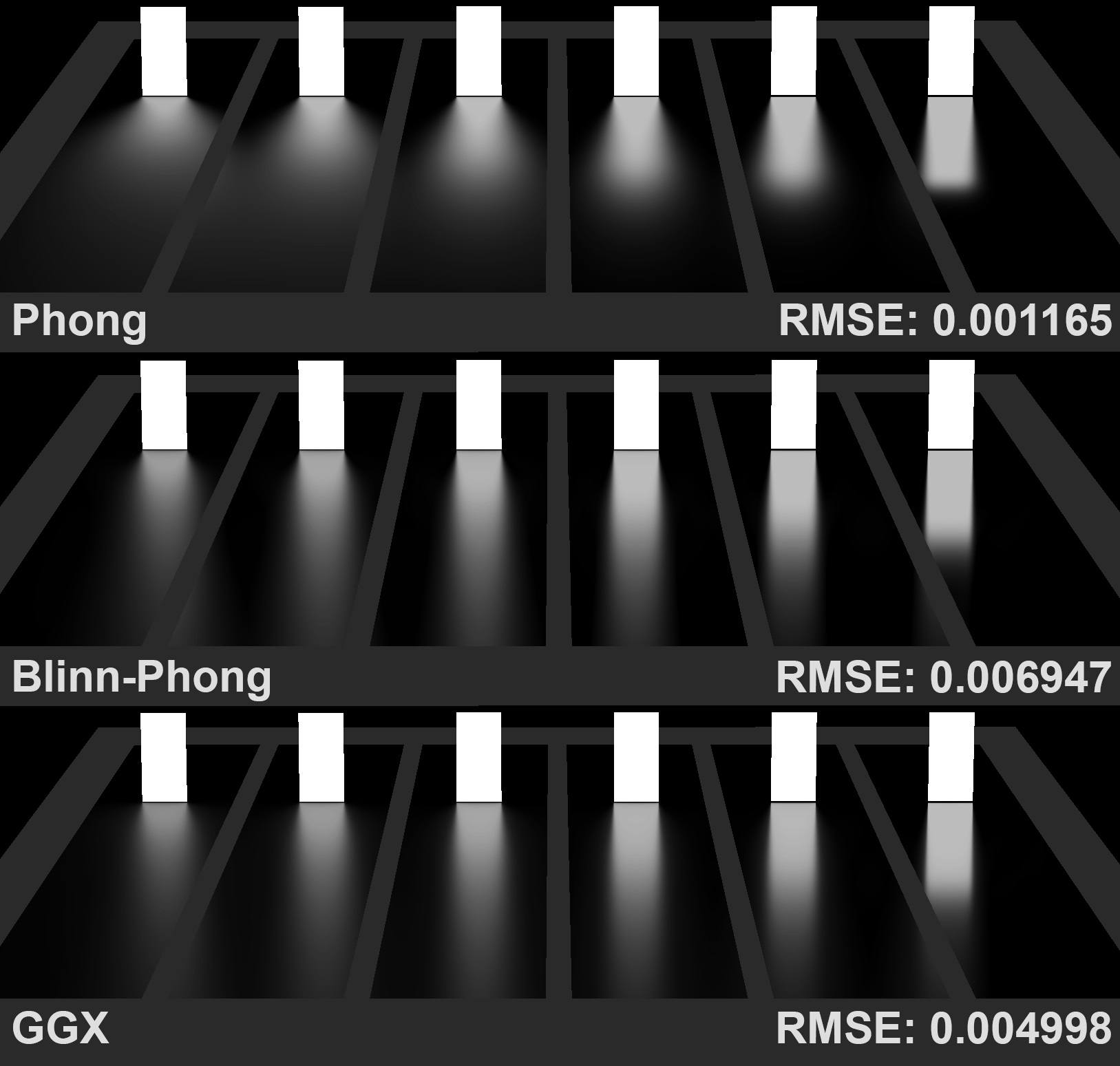
Accurate Analytic Approximations for Real-Time Specular Area Lighting
Pascal Lecocq, Arthur Dufay, Gaël Sourimant, Jean-Eudes MarvieIn proceedings of ACM SIGGRAPH i3D 2016,
Best Paper award by paper chairs, Best Presentation award by votes from conference attendees.
This paper is the detailed version of the SIGGRAPH talk presented in 2015 with several extensions. Main contibutions are: a general framework for approximating and evaluating the edge integrals in O(1) time instead of O(n) using simple and integrable peak shape functions. A low-cost edge splitting strategy for handling the warp distortion introduced by the half vector parameterization that preserves the highlight shape of microfacet BRDF. An original spinning algorithm enabling spherical and disc area lighting that benefits from our approximations and supports non-uniform scale operations. Timings on recent GPU available in additional notes.
[pdf] [video stream] [video] [bib] [additional notes] [slides pptx + error analysis]

Accurate Analytic Approximations for Real-Time Specular Area Lighting
Pascal Lecocq, Gaël Sourimant, Jean-Eudes MarvieIn SIGGRAPH 2015 Talks
We introduce analytic approximations for accurate real-time rendering of specular surfaces illuminated by polygonal light sources. Our solution is based on a reformulation of the contour integral [Arvo 1995] we approximate analytically with simple peak functions. In addition, using simple geometric operations, we extend the solution to handle the half-vector transform and represent more physically plausible BRDF. Our solution works without any assumption on light source shape nor surface roughness, bringing real-time performances with a quality close to the ground truth.
[pdf] [video] [bib]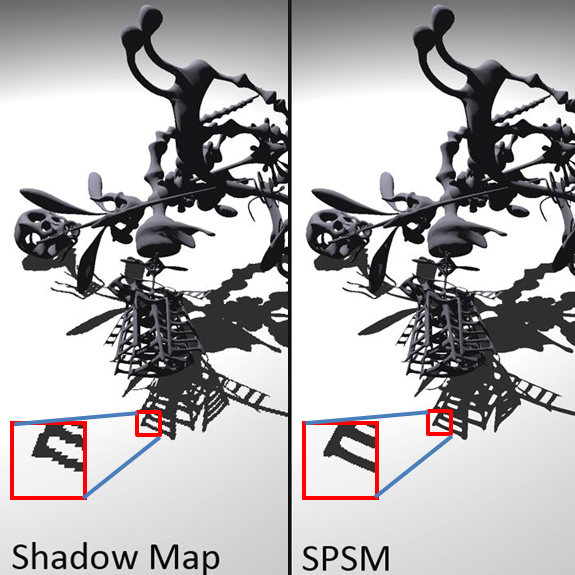
Sub-Pixel Shadow Mapping
Pascal Lecocq, Jean-Eudes Marvie, Gaël Sourimant, Pascal GautronIn Proceedings of ACM I3D 2014
Sub-pixel shadow maps are an alternative to the conventional shadow mapping technique allowing the real-time rendering of "near" alias-free shadows with strong temporal consistency. Our technique is based on the storage of a fixed-size partial representation of the scene geometry using conservative rasterization. Combined with an original reconstruction of shadow edges, our method avoids both perspective and projection aliasing with only a small computational overhead.
[pdf] [video] [bib]
Boundary-Aware Extinction Mapping
Pascal Gautron, Cyril Delalandre, Jean-Eudes Marvie, Pascal LecocqIn proceedings of Pacific Graphics 2013
Boundary-Aware Extinction Maps targets interactive rendering of massive heterogeneous volumetric datasets. Our approach is based on the projection of the extinction along light rays into a boundary-aware function space, focusing on the most relevant sections of the light paths. This technique also provides an alternative representation of the set of participating media, allowing scattering simulation methods to be applied on arbitrary volume representations.
[pdf] [video] [bib]
Sub-Pixel Shadow Mapping
Pascal Lecocq, Pascal Gautron, Jean-Eudes Marvie, Gaël SourimantIn SIGGRAPH 2013 Talks
Sub-pixel shadow maps are an alternative to the conventional shadow mapping technique allowing the real-time rendering of "near" alias-free shadows with strong temporal consistency. Our technique is based on the storage of a fixed-size partial representation of the scene geometry using conservative rasterization. Combined with an original reconstruction of shadow edges, our method avoids both perspective and projection aliasing with only a small computational overhead.
[pdf] [video] [bib]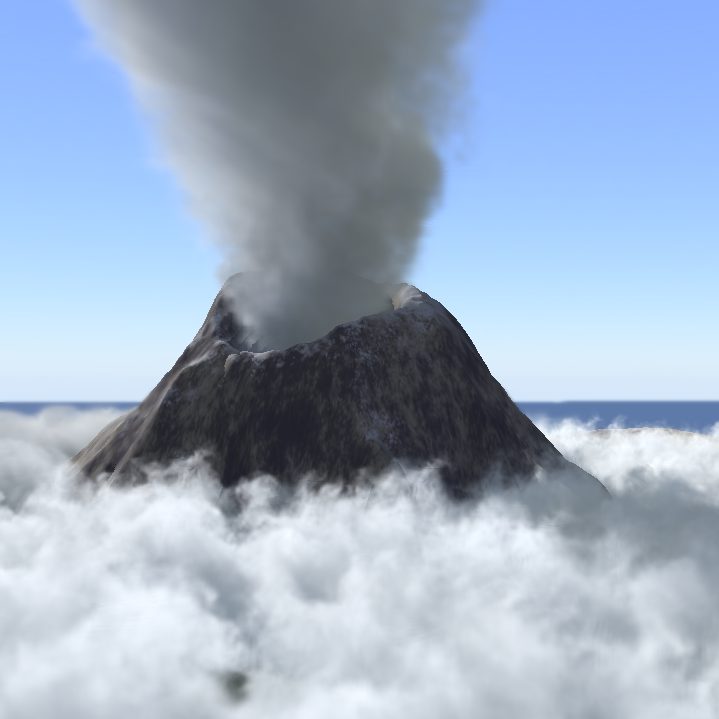
Volume-Aware Extinction Mapping
Pascal Gautron, Cyril Delalandre, Jean-Eudes Marvie, Pascal LecocqIn SIGGRAPH 2012 Talks
The Volume-Aware Extinction Maps accounts for multiple animated participating media, without assumptions on their relative positions and nature. The approach is based on the projection of the extinction function along light rays into a volume-aware functional space, concentrating the representation accuracy within the most relevant sections of the light paths. We demonstrate the use of our technique for interactive editing and navigation in complex volumetric scenes using a simple out-of-core rendering framework, making VAEM valuable tools for real-time rendering applications as well as production pre-visualization.
[pdf] [video] [bib]
Streaming and Synchronization of Multi-User Worlds Through HTTP/1.1
Jean-Eudes Marvie, Pascal Gautron, Pascal Lecocq, Olivier Mocquart, François GérardIn Proceedings of ACM Web3D 2011
We propose an approach for adaptive streaming of on-line multi-user virtual worlds, using generic transfer protocols and a unified representation of the worlds usable on an arbitrary wide range of platforms. HTTP/1.1 natively supports two crucial features for data streaming: persistent connections and chunked access to files. Based on those simple capabilities we propose unified representations of arbitrarily large virtual worlds based on X3D, as well as methods for adaptive streaming and interaction regardless of the network bandwidth or capabilities of the client hardware.
[pdf] [video] [bib]
Assessment of the Simulation of Low Beams Back-Scattering in Fog
Dumont E., Paulmier G., Lecocq P., Kemeny A6th International Symposium on Automotive Lighting, ISAL 2005
In this paper, we address the backscattered veil caused by low beam headlamps in fog. We use a computational approach, based on a Monte Carlo light tracing technique which allows us to compute the backscattered luminance distribution in the driver's field of vision. We investigate several hypotheses (far field photometry, single scattering, and absence of volume shadows). We examine the influence of these approximations on the average backscattered luminance in a 20° solid angle for various fog conditions, and draw conclusions concerning their validity for a particular set of headlamps.
[link to the paper]
Integration of AFS-functionality into driving simulators
Rudolf B., Schmidt J., Grimm M., Kalze F.-J., Wördenweber B., Lecocq. P., Kemeny A., Panerai F.Proceedings of the Driving Simulation Conference, DSC 2004
Around 55,000 people are killed each year in accidents throughout the European Community. Night- time driving with conventional headlamps is particularly unsafe: only 25% of the driving is done at night but 55% of the driving fatalities occur during this period. In order to reduce these figures, new automotive lighting technologies (Advanced Front Lighting System AFS) are about to be permitted in ECE legislation. This paper presents both, integration of pre- and full AFS into a driving simulator considering constraints such as the accuracy of photometric data, the integration of AFS control strategies in a driving simulation loop and realistic real-time rendering.
[pdf]
Lighting Simulation With the Presence of Fog: a Real-Time Rendering Solution For Driving Simulators
Pascal Lecocq, Sylvain Michelin, Andras Kemeny, Didier ArquesProceedings of the Driving Simulation Conference, DSC 2002
Driving simulators are increasingly used to assess healdlight design prior to their conception thanks to the introduction of interactive headlight simulation tools. Although, by assuming clear weather conditions, these solutions fail to early detect the presence of potentially disturbing light shafts occuring under foggy weather condition. This paper introduces a real-time rendering technique allowing proper representation of such light shafts, suitable for driving simulators. The solution relies on mathematical reformulation and approximation of the light transport equation combined with a screen space rendering technique for real-time efficiency. Implemented on a driving simulator, our solution can be applied for the oncoming traffic headlights as well as for driver's headlight.
[pdf] [video from my PhD defense (2001)]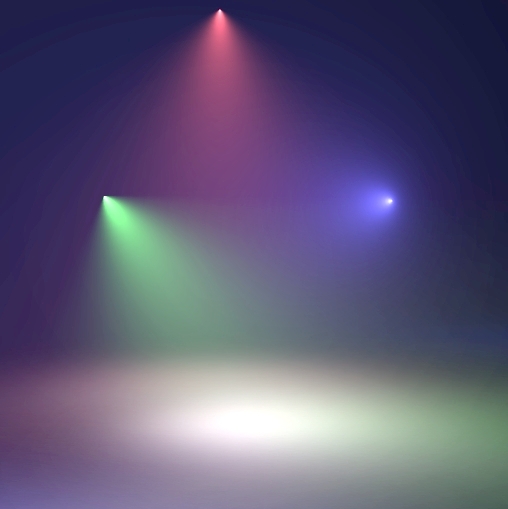
Mathematical Approximation for Real-Time Lighting Rendering Through Participating Media
Pascal Lecocq, Andras Kemeny, Sylvain Michelin, Didier ArquèsProceedings of the 8th Pacific Conference on Computer Graphics and Applications, PG 2000
Many shading models are able to provide realistic rendering of lighting effects under various atmospheric conditions but computational times are often expensive. This paper proposes a method to render lighting effects within participating media in real-time on a graphics workstation. It consists of mathematical approximations based on a re-formulation of the light transport equation considering atmospheric scattering with light sources described by their luminous intensity distribution. The proposed approximations allow constant-time evaluation of the air-light integral and use graphics hardware capabilities of workstations to accelerate parts of the rendering process.
[pdf] [bib]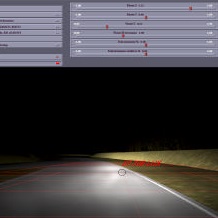
Interactive Headlight Simulation
Pascal Lecocq, Jean-Marc Kelada, Andras KemenyProceedings of the Driving Simulation Conference, DSC 1999
This paper introduces the interactive headlight simulation software developed at Renault Research department. The software aims to reduce the cost and delay of headlamp prototyping using virtual headlamp assessment in a driving simulator. Accurate rendering and lighting of the road is achieved in real-time using a photometric description of the headlamp encoded in a texture and a specific level of detail management. During the driving experience, several parameters can be adjusted in real-time, such as the position and the orientation of the headlamps. The headlight simulation software was integrated in Renault's driving simulators in 1998 and validated by Renault's photometric laboratory.
[pdf]